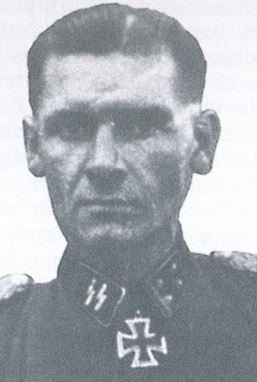Bunse, Fritz (Waffen SS)
- Date of birth:
- July 4th, 1911 (Hagen/Western Phalia, Germany)
- Date of death:
- September 14th, 1970 (Herne, Germany)
- Service number:
- SS-Nr.: 30.303 // NSDAP-Nr.: 728.406
- Nationality:
- German (1933-1945, Third Reich)
Biography
00.00.1931: joined the NSDAP
00.03.1933: joined the SS-VT
00.00.1933: SS-Stabswache Berlin
00.00.1936-00.00.1937: SS-Junkerschule in Braunschweig
20.04.1937: promoted to SS-Untersturmführer
00.05.1937: SS-Ustuf, Führer, 1. Kompanie, SS-Pionier-Standarte
11.09.1938: promoted to SS-Obersturmführer
00.05.1940: campaign in France
30.01.1941: promoted to SS-Hauptsturmführer
00.06.1941: SS-Hstuf, Chef, 16. (Pi.) Kompanie, SS-Panzergrenadier-Regiment 9 'Germania', 5. SS-Division 'Wiking' - Barbarossa
00.07.1942-00.06.1943: SS-Hstuf, Führer, Lehrgruppe II, Unterführer-Ausbildung, SS-Pionierschule
21.06.1943: promoted to SS-Sturmbannführer
00.06.1943: SS-Stubaf, Kdr, SS-Pionier-Bataillon 11, 11. SS-Freiwilligen-Panzergrenadier-Division 'Nordland' - Battle of Narva
21.06.1944: promoted to SS-Obersturmbannführer
05.08.1944-08.11.1944: SS-Ostubaf, Kdr, SS-Panzergrenadier-Regiment 49 'De Ruyter', 11. SS-Freiwilligen-Panzergrenadier-Division 'Nordland'
10.11.1944: SS-Ostubaf, Korps-Pionierführer 105, V. SS-Freiwilligen-Gebirgskorps
Do you have more information about this person? Inform us!
- Period:
- Second World War (1939-1945)
- Rank:
- SS-Obersturmführer (Lieutenant)
- Unit:
- Chef, 1. Kompanie, SS-Pionier-Regiment, SS-VT
- Awarded on:
- June 3rd, 1940
- Period:
- Second World War (1939-1945)
- Rank:
- SS-Hauptsturmführer (Captain)
- Unit:
- Chef, 16. Kompanie, SS-Panzergrenadier-Regiment 9 'Germania', 5. SS-Division 'Wiking'
- Awarded on:
- August 12th, 1941
- Period:
- Second World War (1939-1945)
- Period:
- Second World War (1939-1945)
- Period:
- Second World War (1939-1945)
- Awarded on:
- 1944
- Period:
- Second World War (1939-1945)
- Rank:
- SS-Sturmbannführer (Major)
- Unit:
- Kommandeur SS-Freiwilligen-Pionier-Bataillon 11 "Nordland" / 11.SS-Division
- Awarded on:
- January 30th, 1944
“On the 12.01.1944 SS-Sturmbannführer Bunse and the the 2. Kompanie of his Pionier-Bataillon were employed for obstacle construction in the forest southeast of Poroshki. After this they withdrew according to schedule on the 14.01.1944 to the lightly constructed Finnish Position. He and his men had barely established themselves here when they were verbally ordered by the commander of the 9. Lw.Feld.Div. to launch a counterattack against the enemy troops that had penetrated near Poroshki. He thus thrust against the much larger enemy while concentrating on neither the left or right, but as he did this he came under enemy attack on his right flank while in the forest. On his own initiative he attacked the enemy who were already in the rear of his right Kompanie and thereafter fought his way back to the Finnish Position (sketch 1).
From here he repelled 8 enemy attacks launched by much larger forces with bloody losses for both the attackers and defenders. His men were already exhausted from their attack through the thick snow, and their inadequate positions were often just holes in the snow. For their part the enemy preceded their attacks with heavy artillery fire and carried out most of them with tank and aircraft support. Both neighbouring units had already pulled back during the last two attacks. The fact that his young unit (which was only newly constituted and comprised 60% young men) was able to hold its ground through all of this is solely thanks to his own ruthless and non-stop personal efforts in the foremost line as well as his exemplary bravery. The result was that his Bataillon was the only unit in the sector to hold its position for 2 days (sketch 2).
After the enemy had penetrated into the position on the evening of the 15.01.1944 he once again threw himself into the close-quarter battle. He was the last to leave the position after the wounded had been evacuated. Covering his men with his machine-pistol, SS-Sturmbannführer Bunse and his men pulled back to a new position on the southeast bank of the river between the estate and village of Lewolowo.
From here, covered on both flanks by 2 Kompanien from the Infanterie-Regiment 176, he fended off 2 further night attacks by the Soviets with only 1 officer, 1 NCO and 11 men (the rest of his Kampfgruppe was by then dead or wounded, see sketch 3).
The enemy was forced to adjust their plans due to the resistance by the SS-Pz.Pi.Btl. 11, as is made clear by an analysis of the radio messages to and from Bunse’s unit (appendix 4).
The outstanding self-sacrifice of the Bataillon, inspired by the example of its commander, meant that the Gruppe “Schwerstes Flachfeuer” was able to escape destruction at the hands of the enemy.”
Sources
- Photo 1:
- - MOONEY, PETER, Waffen-SS Knights and their Battles, Schiffer Military History, 2016.
- Die Ordensträger der Deutschen Wehrmacht (CD), VMD-Verlag GmbH, Osnabrück, 2002
- Fellgiebel W.P., Elite of the Third Reich, The recipients of the Knight's Cross of the Iron Cross 1939-1945: A Reference, Helion & Company Limited, Solihull, 2003, ISBN 1-874622-46-9
- Microfilm Publication A3343. US National Archives.












